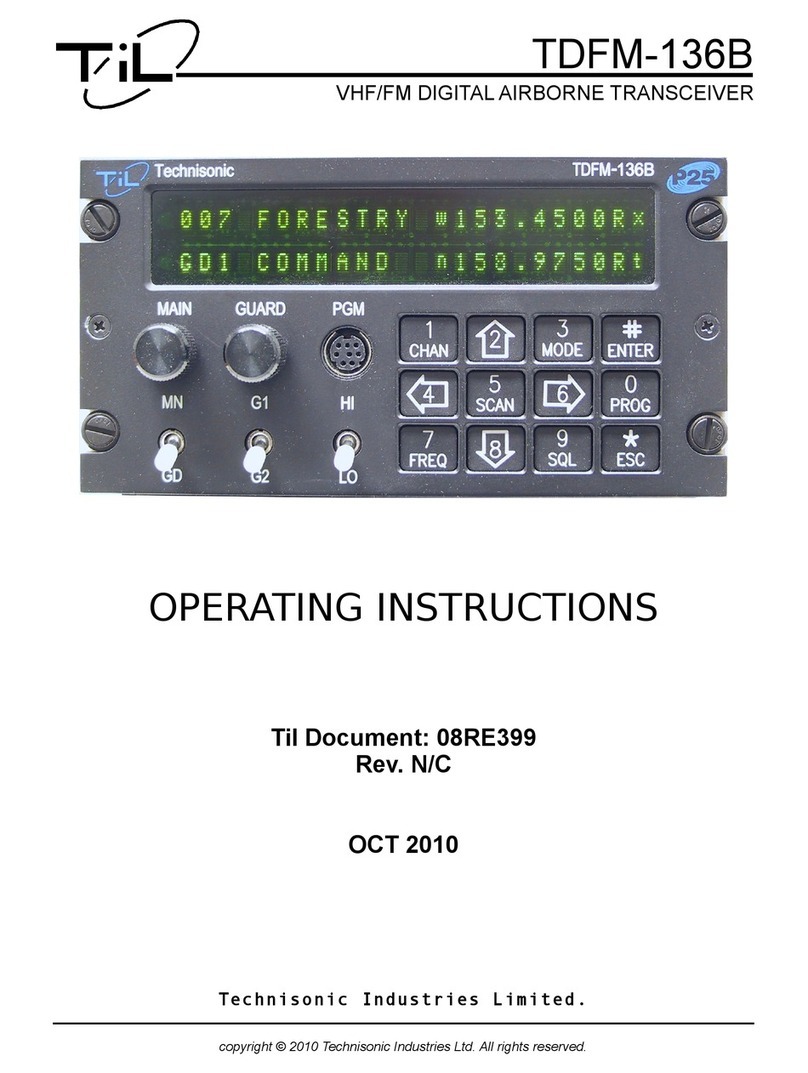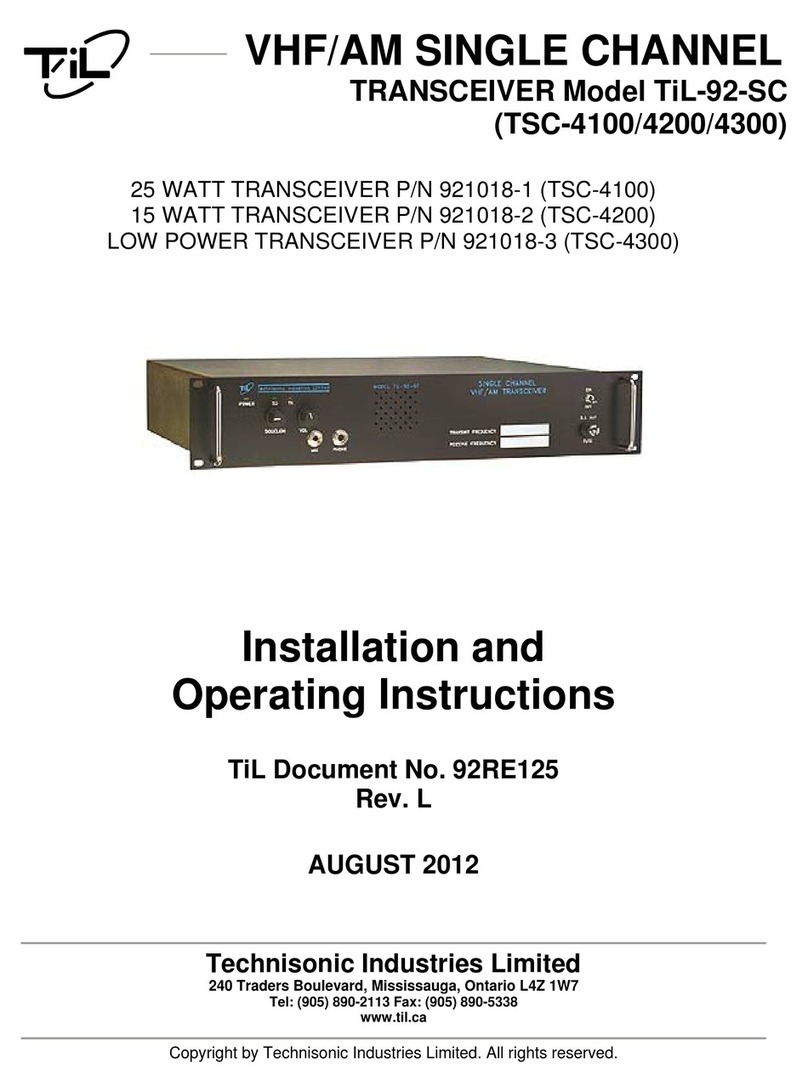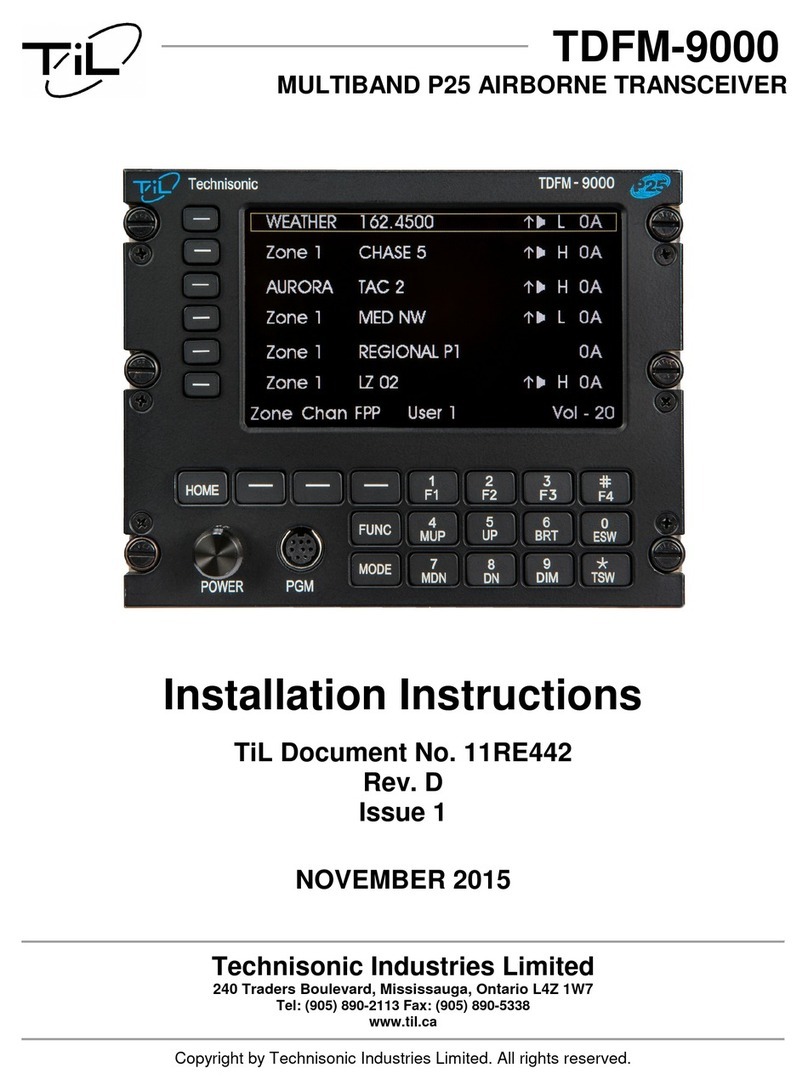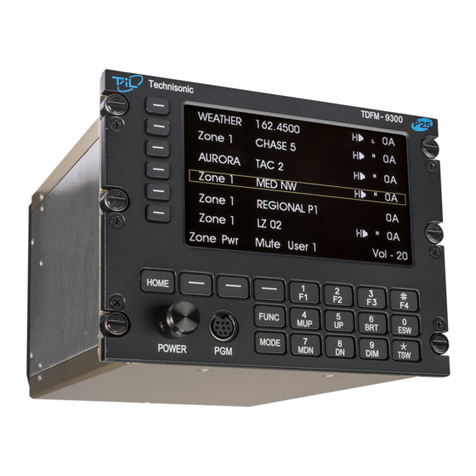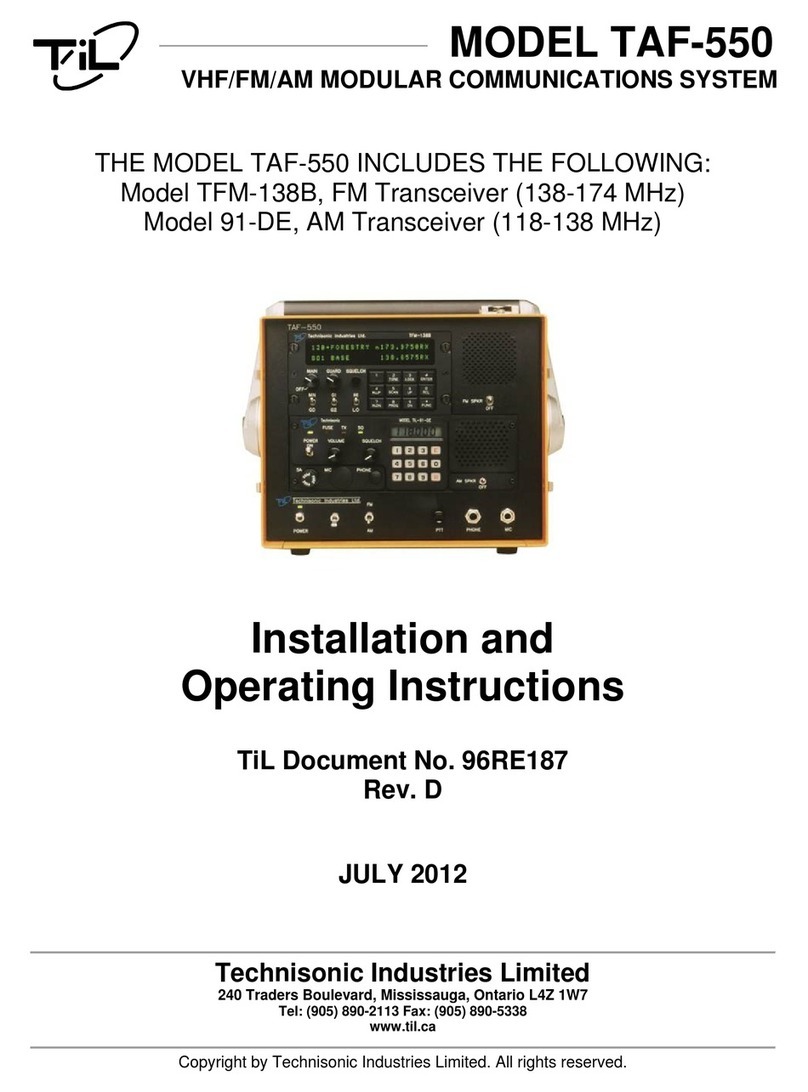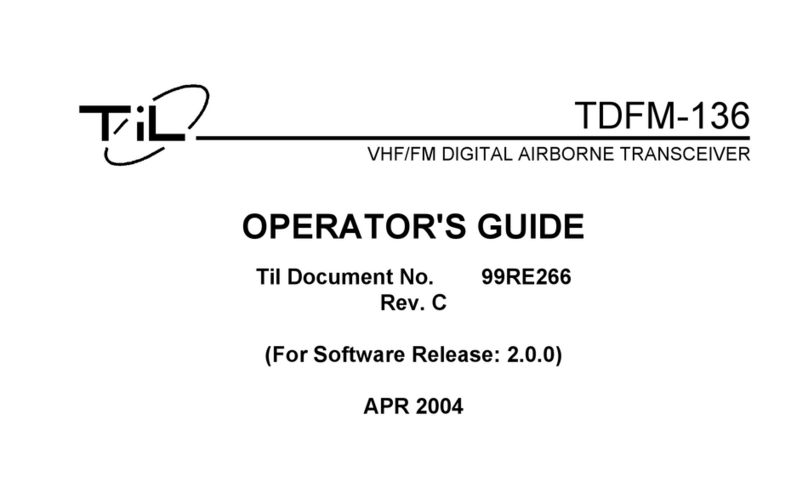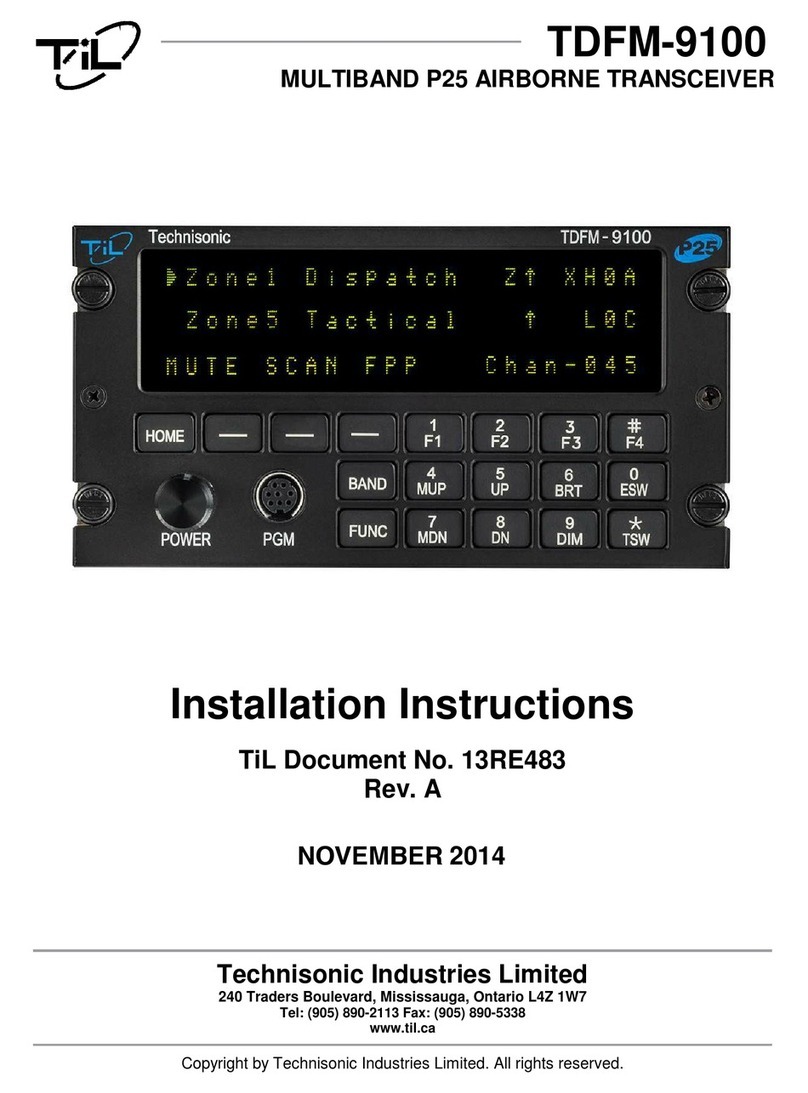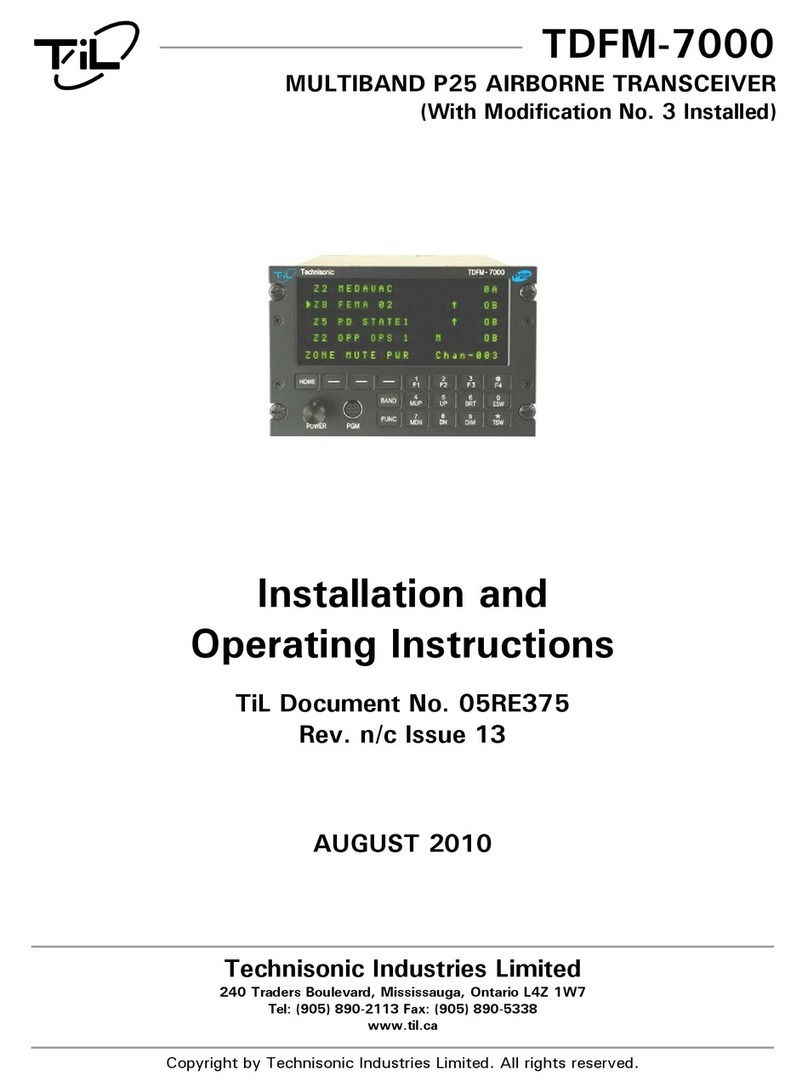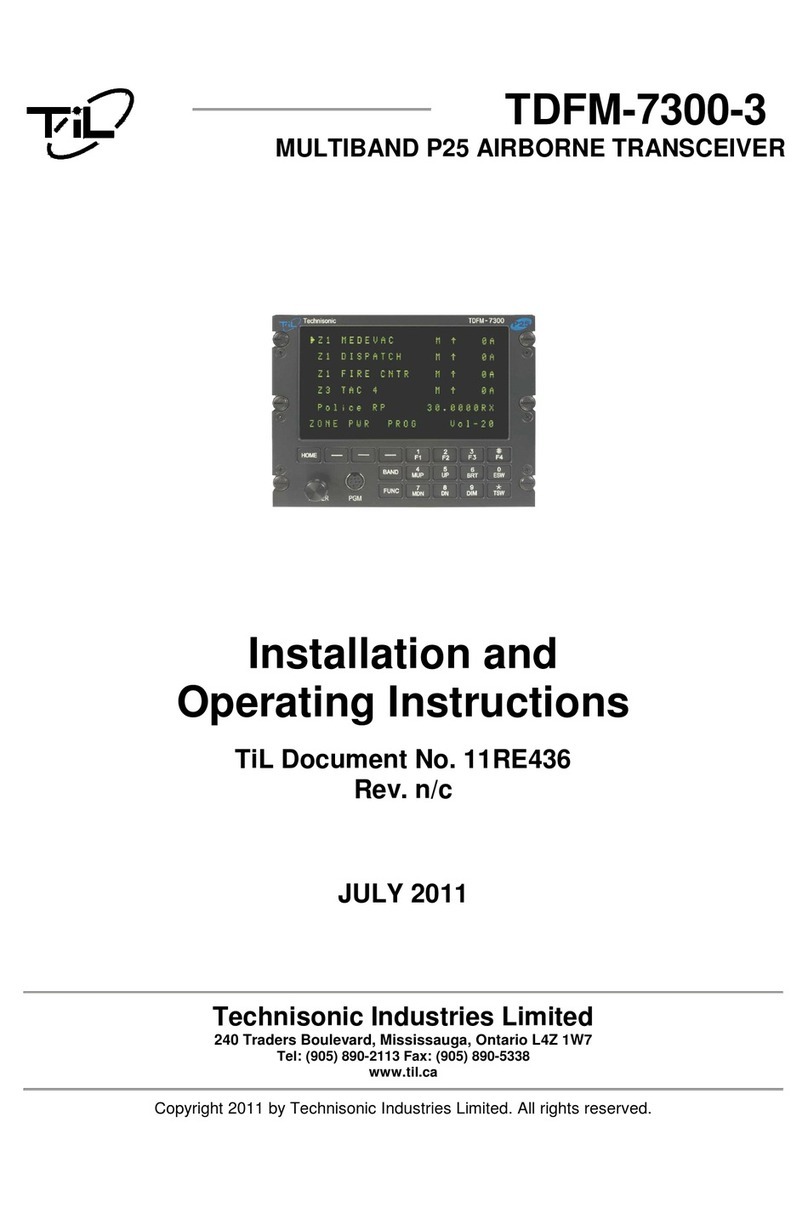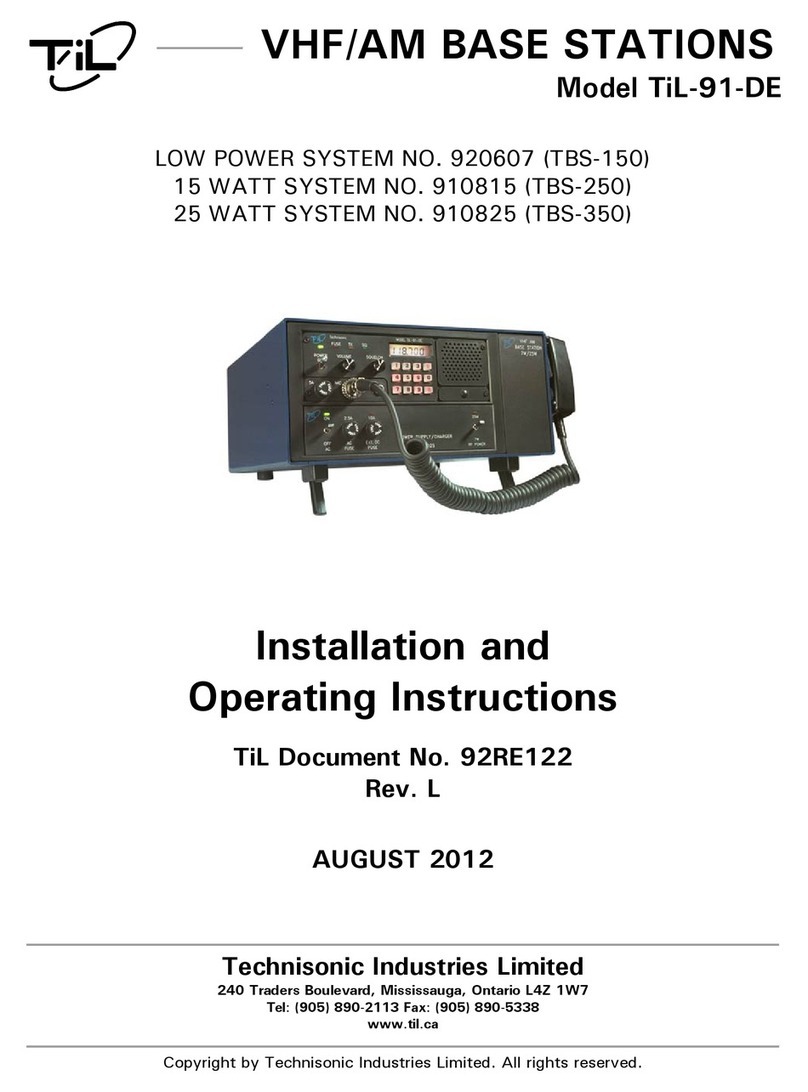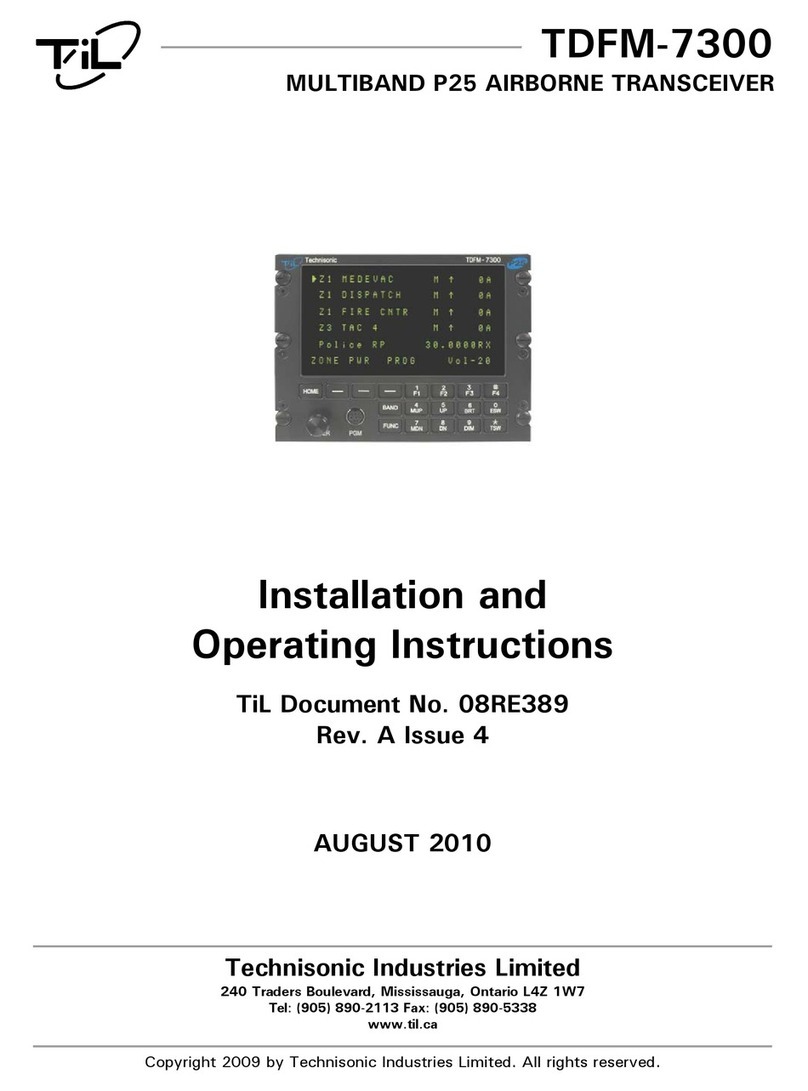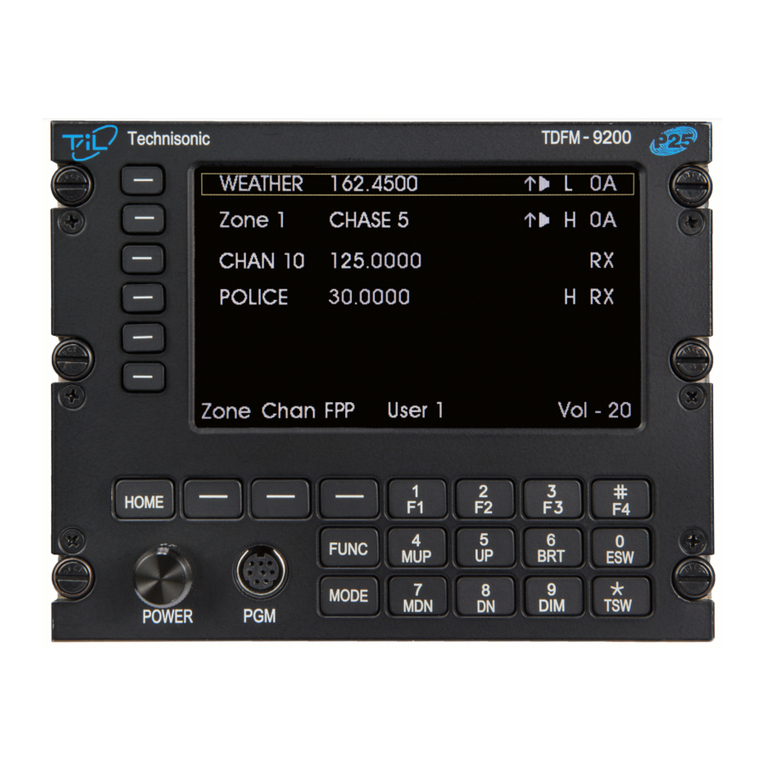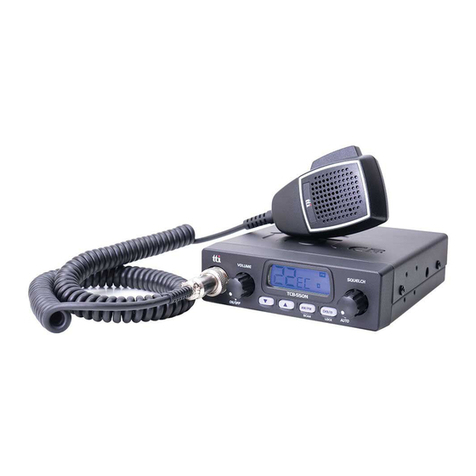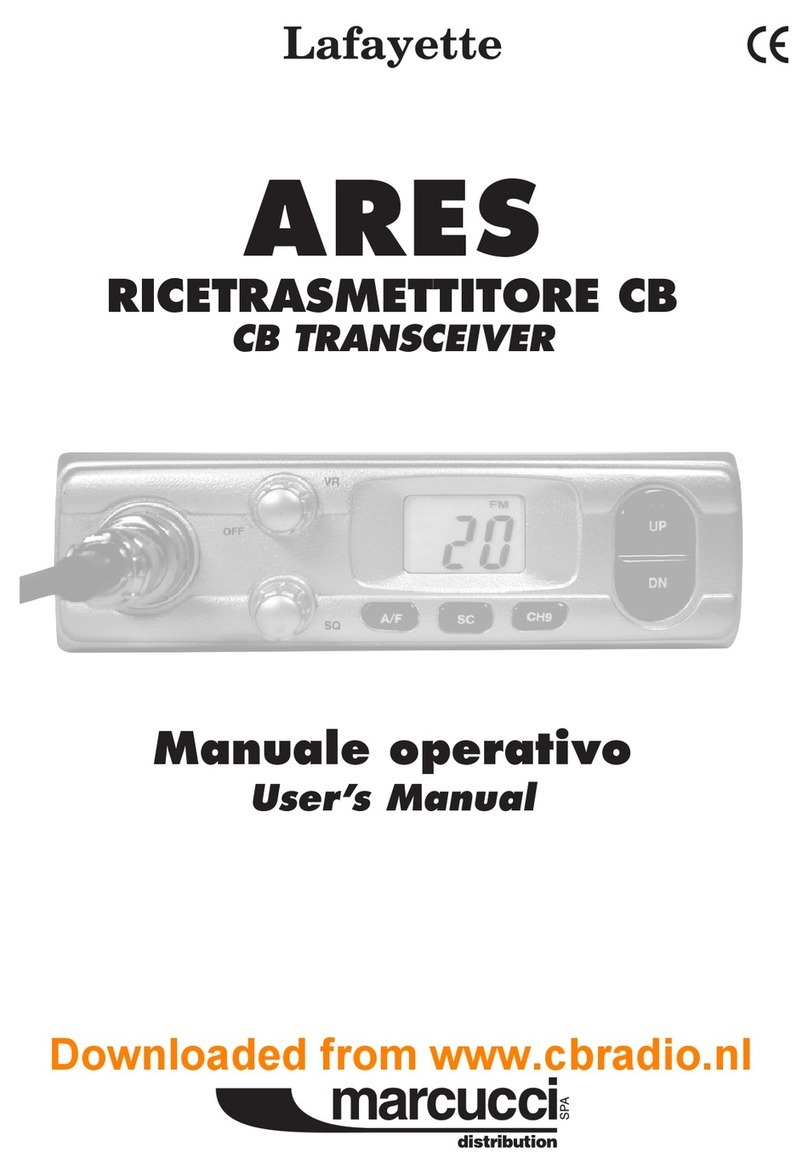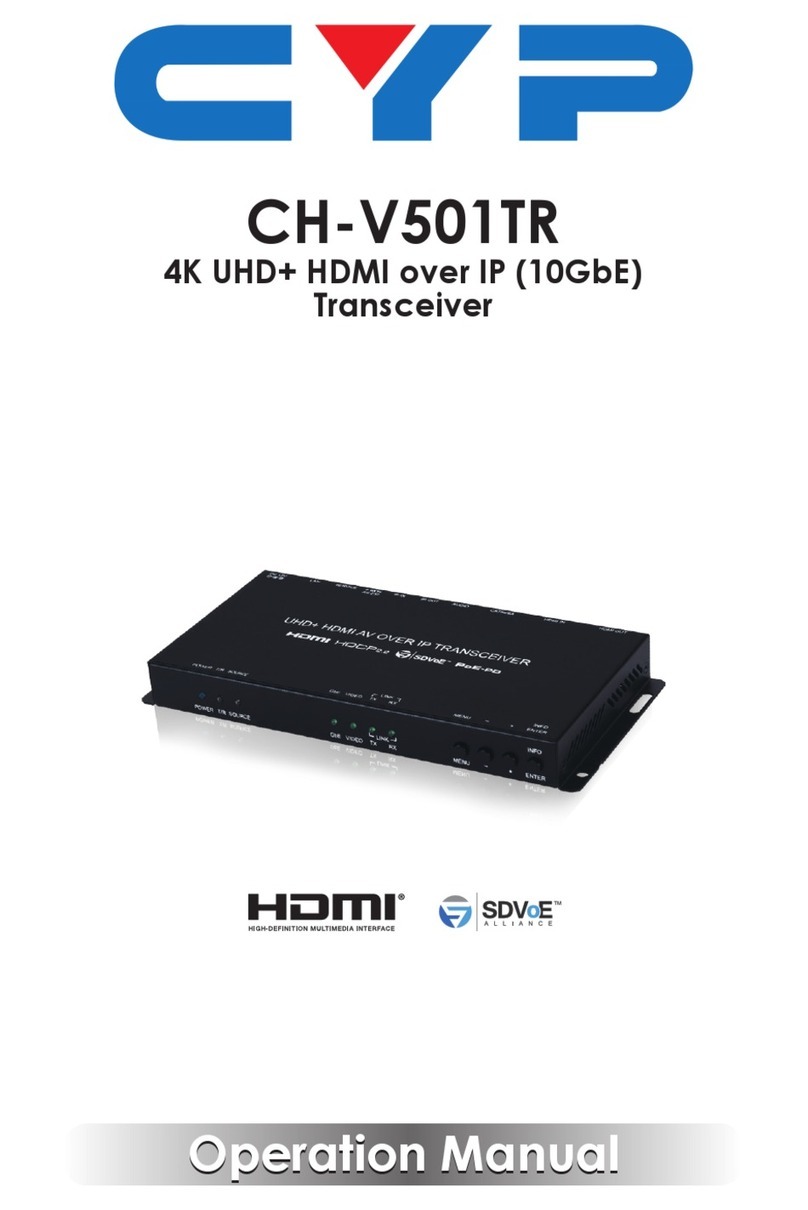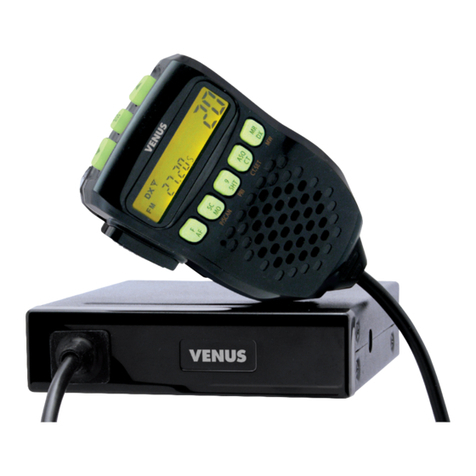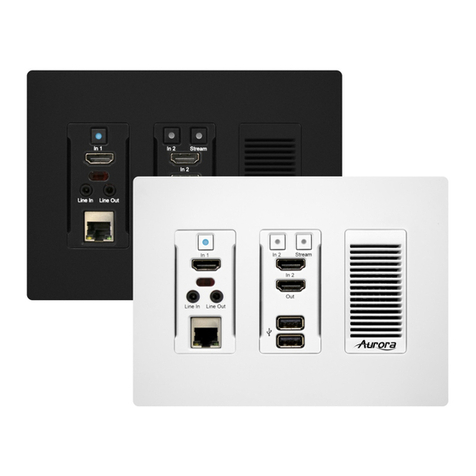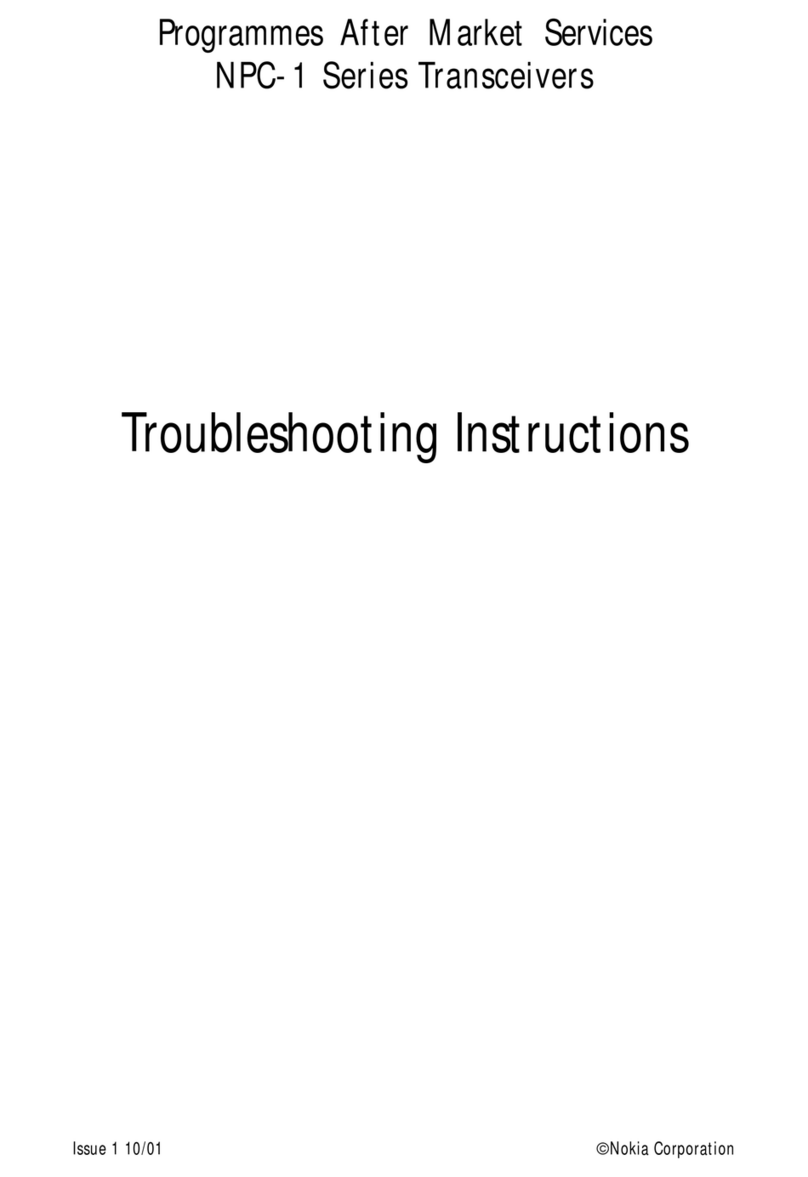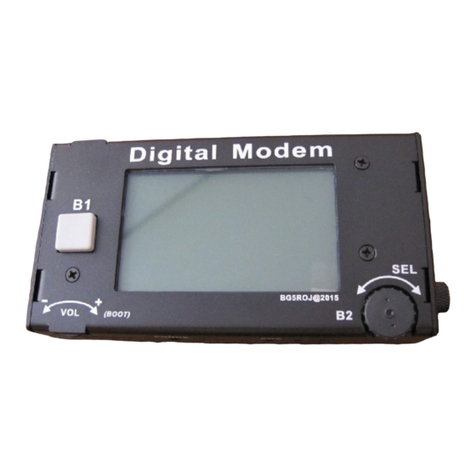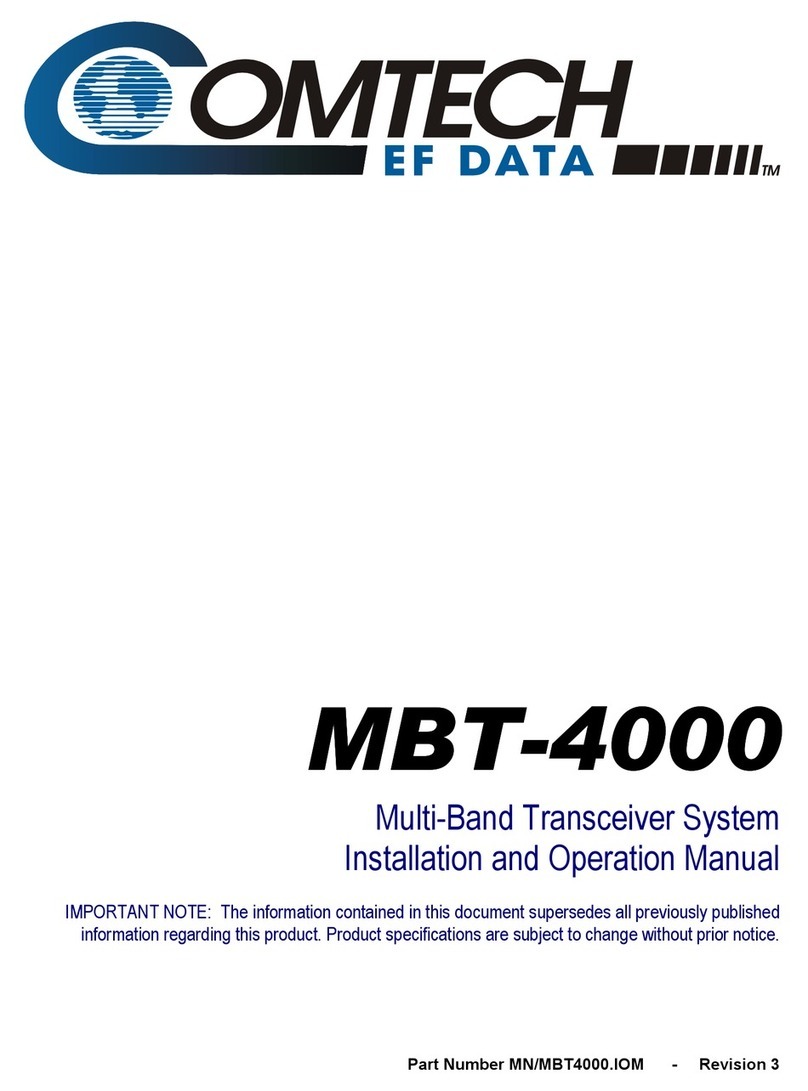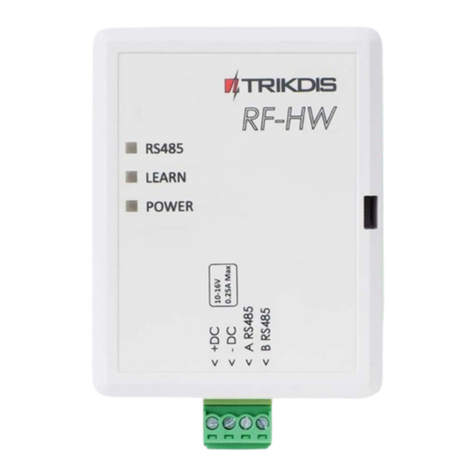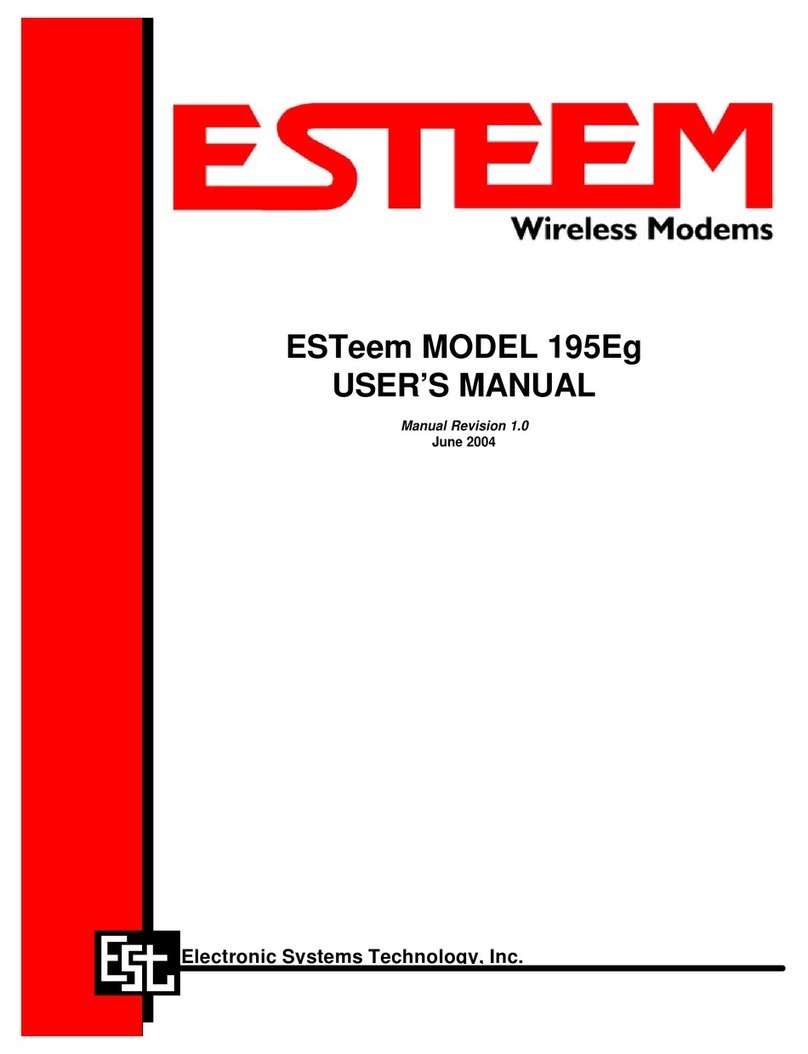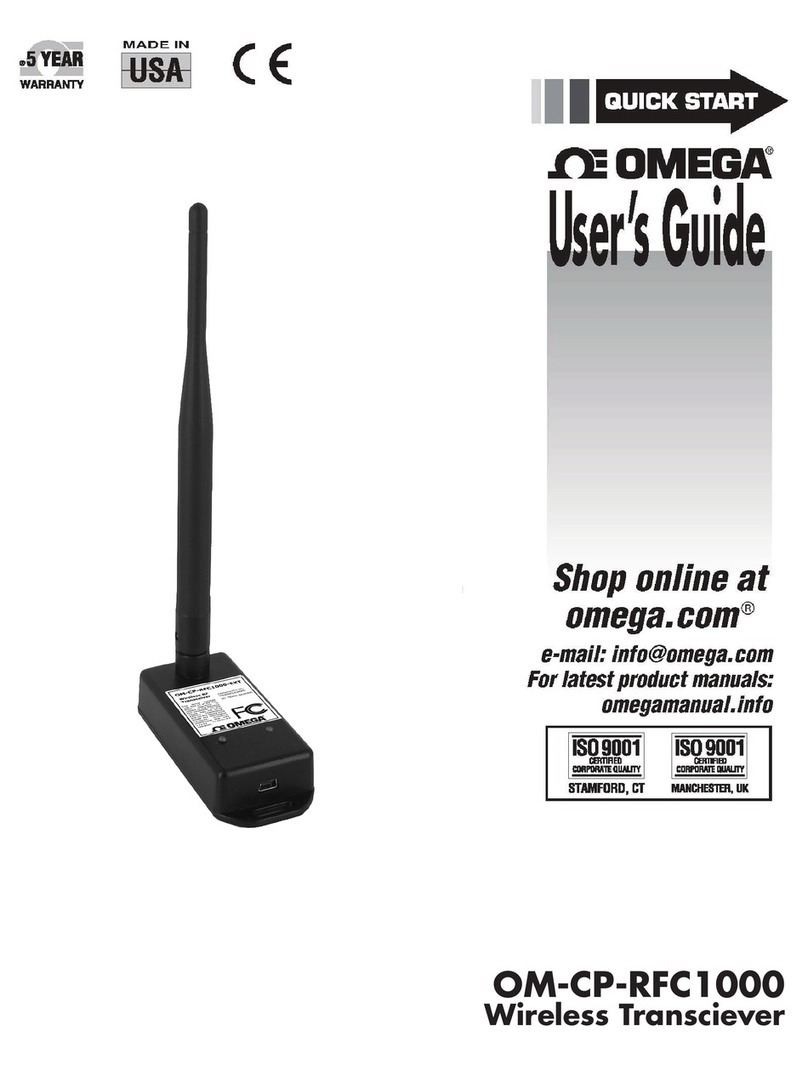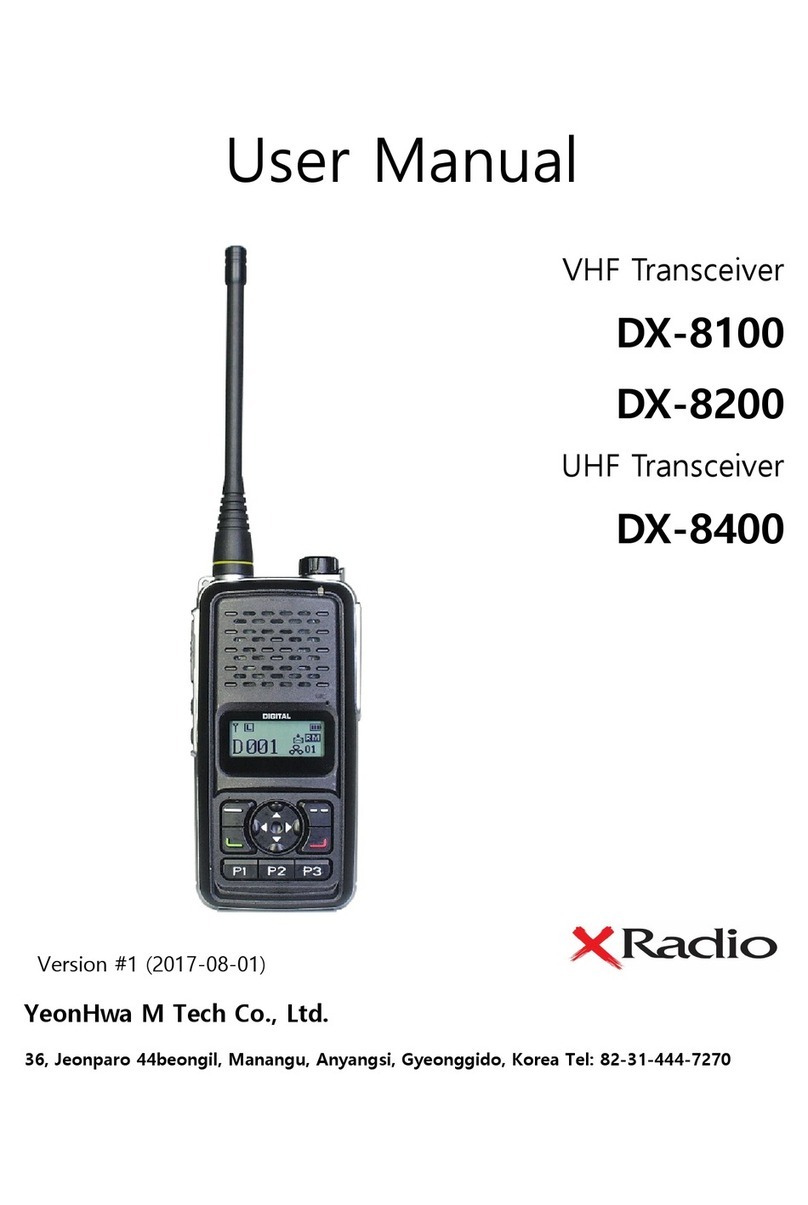TIL TDFM-7300-2 User manual

TDFM-7300-2
MULTIBAND P25 AIRBORNE TRANSCEIVER
Installation and
Operating Instructions
TiL Document No. 10RE430
Rev. A
NOVEMBER 2010
Technisonic Industries Limited
240 Traders Boulevard, Mississauga, Ontario L4Z 1W7
Tel: (905) 890-2113 Fax: (905) 890-5338
www.til.ca
Copyright 2009 by Technisonic Industries Limited. All rights reserved.


REVISION HISTORY
[ 10RE430 ]
REV SECTION
- PAGE - DESCRIPTION DATE Edited by
A iii Changed 70cm to 80cm. 26 Nov 2010 SM


TDFM-7300-2 Installation & Operating Instructions TiL 10RE430A
iii
NOTES
CAUTION ! STATIC SENSITIVE !
This unit contains static sensitive devices. Wear a grounded wrist strap and/or conductive gloves
when handling printed circuit boards.
FCC COMPLIANCE INFORMATION
This device complies with Part 15 of the FCC Rules. Operation is subject to the following two conditions:
(1) this device may not cause harmful interference and (2) this device must accept any interference
received, including interference that may cause undesired operation.
WARNING: For compliance with FCC RF Exposure Requirements the mobile transmitter
antenna installation shall comply with the following two conditions:
1. The transmitter antenna gain shall not exceed 3 dBi.
2. The transmitter antennas shall be located outside of a vehicle and must not be co-located (kept at
a separation distance of more than 20cm from each other when installed). Also they must be
installed in such a way that they always maintain a separation distance of more than 80cm from
any person during operation.
NOTE: This equipment has been tested and found to comply with the limits for a Class A digital device,
pursuant to Part 15 of the FCC Rules. These limits are designed to provide reasonable protection against
harmful interference when the equipment is operated in a commercial environment. This equipment
generates, uses, and can radiate radio frequency energy and, if not installed and used in accordance with
the instruction manual, may cause harmful interference to radio communications. Operation of this
equipment in a residential area is likely to cause harmful interference, in which case the user will be
required to correct the interference at his/her own expense.
WARNING
Changes or modifications not expressly approved by Technisonic Industries could void the user’s
authority to operate the equipment.
WARRANTY INFORMATION
The Model TDFM-7300-2 Transceiver is under warranty for one year from date of purchase.
Failed units caused by defective parts, or workmanship should be returned to:
Technisonic Industries Limited
240 Traders Boulevard
Mississauga, Ontario L4Z 1W7
Tel: (905) 890-2113
Fax: (905) 890-5338

TDFM-7300-2 Installation & Operating Instructions TiL 10RE430A
iv
Summary of DO-160C Environmental Testing for Technisonic Model TDFM-7300-2 Transceiver.
CONDITIONS SECTION DESCRIPTION OF CONDUCTED TESTS
Temperature and Altitude 4.0 Equipment tested to categories C4 and D1.
Vibration 8.0 Equipment is tested without shock mounts to categories
B, M and N.
Magnetic Effect 15.0 Equipment is class Z.
Power Input 16.0 Equipment tested to category B.
Voltage Spike 17.0 Equipment tested to category B.
RF Emission 21.0 Equipment tested to category Z.
STC APPROVAL NOTE
Presently, no TSO standard exists for airborne FM transceivers. To make it easier for installation
agencies to provide their customers with an approved installation supported by an effective Airworthiness
Approval, Technisonic has secured Supplemental Type Certificate (STC) Approvals (both US and
Canadian) on its Airborne FM products for many helicopters currently being delivered in the US and
Canada as well as a number of single engine fixed wing aircraft. The above referenced DO-160C test
data is also on file and available from Technisonic to support approval requirements in airframes for
which Technisonic does not possess an STC.
Approved aircraft types are listed in the attachments to the formal STC documents. These STCs are the
exclusive property of Technisonic and require the written authority of Technisonic for their use. To assist
Factory Authorized Technisonic Dealers in the certification process, we have placed copies of our
Canadian and US STCs on our web site along with a letter of authorization for their use. These
documents may be downloaded and used as support for the technical submission to FAA or Transport
Canada. Only authorized factory dealers/installers are permitted to download and make use of these
documents on behalf of their customers (end users) in support of regulatory agency approval. Please
refer to the Technisonic web site www.til.ca for the latest issue of available STCs and letter of
authorization for use.
COPYRIGHT NOTICE
This document contains designs and other information which are the property of Technisonic Industries
Ltd. Except for rights expressly granted by contract to the Canadian Government, or to the United States
Government, this document may not, in whole or in part, be duplicated or disclosed or used for
manufacture of the part disclosed herein, without the prior permission of Technisonic Industries Ltd.
WARNING AND DISCLAIMER
This manual is designed to provide information about the TDFM-7300-2. Every effort has been made to
make this manual as complete and accurate as possible.
TRADEMARK NOTICES
TDFM-7300-2 Transceivers contain two-way radio protocols licensed from Motorola, Inc.
© 1997, 1998 Motorola, Inc.

TECHNISONIC INDUSTRIES LIMITED
www.til.ca
TDFM-7300-2 Installation & Operating Instructions TiL 10RE430A
v
TABLE OF CONTENTS
SECTION 1 GENERAL DESCRIPTION
1.1 INTRODUCTION ...................................................................................................................... 1-1
1.2 DESCRIPTION ......................................................................................................................... 1-1
1.3 MODEL VARIATION ................................................................................................................ 1-1
1.4 TECHNICAL CHARACTERISTICS .......................................................................................... 1-4
SECTION 2 OPERATING INSTRUCTIONS
2.1 GENERAL ................................................................................................................................ 2-1
2.2 FRONT PANEL ........................................................................................................................ 2-1
2.3 POWER SWITCH ..................................................................................................................... 2-2
2.4 KNOB ....................................................................................................................................... 2-2
2.5 SOFT KEYS AND HOME ......................................................................................................... 2-2
2.6 BAND KEY ............................................................................................................................... 2-3
2.7 FUNC KEY ............................................................................................................................... 2-3
2.8 F1 to F4 KEYS .......................................................................................................................... 2-3
2.9 MUP(4) AND MDN(7) KEYS (Memory Up and Down Keys) .................................................... 2-5
2.10 UP(5) AND DOWN(8) KEYS .................................................................................................... 2-5
2.11 BRT(6) AND DIM(9) KEYS ....................................................................................................... 2-5
2.12 ESW(0) KEY (Ergo Switch Key) ............................................................................................... 2-6
2.13 TSW(*) KEY (Toggle Switch Key) ............................................................................................ 2-6
2.14 DISPLAY .................................................................................................................................. 2-6
2.15 GENERAL OPERATION .......................................................................................................... 2-6
2.16 CUSTOMER PROGRAMMING SOFTWARE (CPS) ............................................................... 2-7
2.17 CONFIGURATION MENU ........................................................................................................ 2-10
2.18 KEYLOADING MODE .............................................................................................................. 2-11
2.19 FRONT PANEL PROGRAMMING (FPP) MODE (Bands 1 – 4) .............................................. 2-12
2.20 FLASH UPGRADE MODE ....................................................................................................... 2-14
2.21 VHF LOW BAND (BAND 5) OPERATION – Analog Module Variances .................................. 2-15
SECTION 3 INSTALLATION INSTRUCTIONS
3.1 GENERAL ................................................................................................................................ 3-1
3.2 EQUIPMENT PACKING LOG .................................................................................................. 3-1
3.3 TRANSCEIVER INSTALLATION ............................................................................................. 3-1
3.4 INSTALLATION KIT - CONTENTS .......................................................................................... 3-1
3.5 ANTENNA INSTALLATION ...................................................................................................... 3-1
3.6 PIN LOCATIONS AND CONNECTIONS ................................................................................. 3-3
3.7 INSTALLATION (WIRING INSTRUCTIONS) ........................................................................... 3-4
3.8 MAIN GROUND ........................................................................................................................ 3-4
3.9 MAIN POWER .......................................................................................................................... 3-4
3.10 MIC 1, 2, 3, 4, AND 5 ............................................................................................................... 3-4
3.11 AUDIO 1, 2, 3, 4, 5 AND COMBINED ...................................................................................... 3-4
3.12 PTT 1, 2, 3, 4, 5 AND COMBINED ........................................................................................... 3-5
3.13 RX DATA AND TX DATA ......................................................................................................... 3-5
3.14 CHANNEL UP / DOWN ............................................................................................................ 3-5
3.15 LH DATA, SB9600 BUSY, OPTB+, CTS OUT, BOOT DIN, RTSBIN and RS232DIN ............. 3-5
3.16 PANEL BACKLIGHTING .......................................................................................................... 3-5
3.17 ANTENNA TUNER CONTROL LINES ..................................................................................... 3-5
3.18 POWER JUMPER .................................................................................................................... 3-5
3.19 POST INSTALLATION EMI TEST ........................................................................................... 3-9
WARRANTY ..........................................................................................................................................

TECHNISONIC INDUSTRIES LIMITED
www.til.ca
TDFM-7300-2 Installation & Operating Instructions TiL 10RE430A
vi
LIST OF FIGURES
FIGURE TITLE PAGE
2.1 Front Panel Controls – TDFM-7300 Series Transceivers ........................................................ 2-1
2.2 PC 7000(II) Programming cable for TYPE II radios P/N 047365-1 .......................................... 2-8
2.3 Encryption Keyload cable for TYPE II radios P/N 037348-1 .................................................... 2-8
2.4 PC 6000(II) Programming cable for TYPE II radios P/N 047366-1 .......................................... 2-9
2.5 USB to Serial Adaptor for Computers without Serial Ports ...................................................... 2-10
3.1 Outline Drawing ........................................................................................................................ 3-2
3.2a Wiring Connections .................................................................................................................. 3-6
3.2b Wiring Connections Notes ........................................................................................................ 3-7
LIST OF TABLES
TABLE TITLE PAGE
2.1 TDFM 7300-2 Series PL/MOT Codes ...................................................................................... 2-13
2.2 TDFM 7300-2 Series DPL Codes (All Bands) .......................................................................... 2-13
2.3 TDFM 7300-2 Analog Band CTCSS/PL Codes ....................................................................... 2-14
3.1 Wire connections on a 25-Pin FEMALE D-Connector ............................................................. 3-3
3.2 Wire connections on a 9-Pin FEMALE D-Connector ............................................................... 3-3
3.3 Wire connections on a 15-Pin [high-density] FEMALE D-Connector ....................................... 3-4

TECHNISONIC INDUSTRIES LIMITED
www.til.ca
TDFM-7300-2 Installation & Operating Instructions TiL 10RE430A
1-1
SECTION 1 - GENERAL
DESCRIPTION
1.1 INTRODUCTION
This publication provides operating and installation information on the TDFM-7300-2 airborne
transceiver. The exact configuration depends on which and how many RF modules are installed.
1.2 DESCRIPTION
The TDFM-7300-2 transceiver is an airborne multi-band radio capable of operation in
conventional analog and P25 digital FM systems, SmartNet/SMART ZONE trunking systems and
P25 9600 trunking systems. Type II RF modules are available in VHF, UHF LO, UHF HI and
700/800 MHz bands.
These optional additional features include P25 9600 Baud trunking that may be combined with
AES and/or DES-OFB encryption with OTAR in any of the available modules.
Bands 1 through 4 on the TDFM-7300-2 are not normally frequency agile. In order to have the
ability to change the frequencies at the front panel, the FPP (front panel programming) option
must be ordered. FPP is only available on the VHF and UHF modules. The FPP option precludes
trunking and limits available channels to 240 (15 zones/16 channels) on that module instead of
1000 channels. Please note that all 240 memories must be filled if FPP is ordered.
The TDFM-7300-2 has provisions for four of the above RF modules as well as one analog only
module. This additional module is fully frequency programmable from the front panel. FM only
modules support CTCSS, DCS, FM wide and narrow band operation. FM bands available are
VLO, VLO2, VHF and UHF.
1.3 MODEL VARIATION
Irrespective of digital module type the bands are numbered 1, 4, 5 and 8 for VHF, UHF low, UHF
Hi and 800/700 respectively. The transceivers part number indicates whether type I (-1, -2) or
type II (-3, -4) modules are installed along with which type of modules are installed. The front
panel LED display will also indicate which type of modules the transceiver contains.

TECHNISONIC INDUSTRIES LIMITED
www.til.ca
TDFM-7300-2 Installation & Operating Instructions TiL 10RE430A
1-2
The following part numbers represent typical TDFM-7300-2 model variations:
3-band TDFM-7300-2 Variations
P/N 061245-1-73U188 One VHF and two 800 MHz, type I modules with Green display.
P/N 061245-3-73U148 One VHF, UHF low and 800/700, type II modules with Green display.
4-band TDFM-7300-2 Variations
P/N 061245-2-73U1558 One VHF, two UHF hi and one 800 MHz, type I modules with Red display
P/N 061245-1-73U1148 Two VHF, one UHF lo and 800/700, type II modules with Green display.
SmartNet and SMART ZONE are trademarks of Motorola, Inc.
TDFM-7300 Model Variations with type I Modules (-1,-2)
4-Band TDFM-7300-2 Model Variations (-73YXXX)
TDFM-7300-2, P/N 061245-1-73YXXX/P73ZZZ GREEN display.
TDFM-7300-2, P/N 061245-2-73YXXX/P73ZZZ RED display.
TDFM-7300NV, P/N 061245-1-73YXXXNV/P73ZZZ GREEN NV display.
5-Band TDFM-7300-2 Model Variations (-73YXXXX)
TDFM-7300-2, P/N 061245-1-73YXXXX/P73ZZZ GREEN display.
TDFM-7300-2, P/N 061245-2-73YXXXX/P73ZZZ RED display.
TDFM-7300-2NV, P/N 061245-1-73YXXXXNV/P73ZZZ GREEN NV display.
Y is an analog module represented by:
U for UHF (403-512 MHz) module
X is a type I digital module represented by: P73ZZZ represents a 4 or 5-digit project number
1 for VHF (138-174MHz) module that identifies specific options that are
4 for UHF Lo (403-470MHz) module contained in the modules. The Technisonic
5 for UHF Hi (450-512MHz) module sales department assigns project numbers
8 for 800 MHz (806-870) based on customer requirements.
Digital module numbers may be specified in any order required. The analog module is always placed on
line 5 of the display. If only 3 digital modules are ordered line 4 of the display will be blank.

TECHNISONIC INDUSTRIES LIMITED
www.til.ca
TDFM-7300-2 Installation & Operating Instructions TiL 10RE430A
1-3
TDFM-7300-2 Model Variations with type II Modules (-3,-4)
4-Band TDFM-7300-2 Model Variations
TDFM-7300-2, P/N 061245-3-73YXXX/P73ZZZ GREEN display.
TDFM-7300-2, P/N 061245-4-73YXXX/P73ZZZ RED display.
TDFM-7300-2NV, P/N 061245-3-73YXXXNV/P73ZZZ GREEN NV display.
5-Band TDFM-7300-2 Model Variations (-73YXXXX)
TDFM-7300-2, P/N 061245-3-7YXXXX/P73ZZZ GREEN display.
TDFM-7300-2, P/N 061245-4-7YXXXX/P73ZZZ RED display.
TDFM-7300-2NV, P/N 061245-3-7YXXXXNV/P73ZZZ GREEN NV display.
Y is a UHF analog module.
X is type II digital module represented by: P73ZZZ represents a 4 or 5 digit project
1 for VHF (138-174MHz) module number that identifies specific options that
4 for UHF Lo (380-470MHz) module are contained in the modules. P7301 and
5 for UHF Hi (450-520 MHz) module up project numbers are used in transceivers
8 for 700/800 MHz (764-870) with type I or type II modules.
Digital module numbers may be specified in any order required. The analog module is always placed on
line 5 of the display. If only 3 digital modules are ordered line 4 of the display will be blank. Hybrid units
that contain a mix of both type I and type II modules will have 061245-3 or –4 part numbers. At this time
only the VHF Lo analog module is available. Contact Technisonic for availability of other analog modules.
All model variations are capable of supporting both 28 Volt DC and 5 Volt AC back lighting. The units are
shipped set to operate on 28 Volt back lighting. Equipment can be set to operate on 5V back lighting by
using the software based configuration menu. See Section 2.18 configuration menu.

TECHNISONIC INDUSTRIES LIMITED
www.til.ca
TDFM-7300-2 Installation & Operating Instructions TiL 10RE430A
1-4
1.4 TECHNICAL CHARACTERISTICS
Specification Characteristic
Model Designation: TDFM-7300-2
Physical Dimensions: Approx. (L) 8.0" x (W) 5.75" x (H) 4.5"
Weight: Approximately 6.0 Lbs (2.7 Kg)
Operating Temperature Range: -30° C to +60° C
Power Requirement:
Voltage:
Current:
28.0 VDC ± 15%
500 mA minimum / 5A maximum
Audio Output Power (including sidetone): 600 mW into 600
Microphone Inputs: Carbon or Equivalent
Panel Back Lighting:
Voltage:
Current:
28 or 5 volts AC/DC (selectable)
10 uA max
Type I Modules
Specification Characteristic
RF Output Power: 1 or 5 Watts (VHF)
1 or 4 Watts (UHF)
1 or 3 Watts (800)
Frequency Range
VHF Module:
UHF LO Module:
UHF HI Module:
800 Module:
136 to 174 MHz
403 to 470 MHz
450 to 512 MHz
806 to 870 MHz
No. of channels per band: 255 pre-programmable channels
Transmitter section VHF UHF 800
FM Hum and noise in dB (wideband):
Frequency Stability in ppm:
Audio Distortion (at 1000Hz):
Modulation Limiting:
-48 -45 -45
±2.0 ±2.0 ±1.5
<2% <2% <2%
Wide band ±5kHz
Narrow band ±2.5kHz
Receiver section VHF UHF 800
Sensitivity in uV:
*Digital 1% BER (12.5kHz)
*Digital 5% BER (12.5kHz)
**Analog with 12dB SINAD
0.35 0.35 0.45
0.25 0.25 0.25
0.25 0.25 0.25
Selectivity in dB:
25 kHz Channel
12.5 kHz Channel
Intermodulation (dB) * **
-78 -78 -75
-67 -68 -63
-78 -77 -74

TECHNISONIC INDUSTRIES LIMITED
www.til.ca
TDFM-7300-2 Installation & Operating Instructions TiL 10RE430A
1-5
Type II Modules
Specification Characteristic
RF Output Power: 1 or 6 Watts (VHF)
1 or 5 Watts (UHF)
1 or 3 Watts (800)
Frequency Range
VHF Module:
UHF LO Module:
UHF HI Module:
700 / 800 Module:
136 to 174 MHz
380 to 470 MHz
450 to 520 MHz
764 to 870 MHz
No. of channels per band: 1000 pre-programmable channels
240 channels (15 zones of 16 channels) for
modules with Front Panel Programming.
Transmitter section VHF UHF 800
FM Hum and noise in dB (wideband):
Frequency Stability in ppm:
Audio Distortion:
Modulation Limiting:
-48 -45 -45
±2.0 ±2.0 ±1.5
1% 1.5% 1.5%
Wide band ±5kHz
Narrow band ±2.5kHz
Receiver section VHF UHF 800
Sensitivity in uV:
*Digital 1% BER (12.5kHz)
*Digital 5% BER (12.5kHz)
**Analog with 12dB SINAD
0.25 0.25 0.40
0.25 0.25 0.25
0.25 0.25 0.25
Selectivity in dB:
25 kHz Channel
12.5 kHz Channel
Intermodulation * **
-80 -78 -72
-63 -63 -63
-78 -77 -75
*Measured in digital mode per TIA / EIA IS 102.CAAA under nominal conditions.
** Measured in analog mode per TIA / EIA 603 under nominal conditions.

TECHNISONIC INDUSTRIES LIMITED
www.til.ca
TDFM-7300-2 Installation & Operating Instructions TiL 10RE430A
1-6
ANALOG MODULE SPECIFICATIONS
GENERAL
Frequency Ranges:
UHF FM analog
403 -512 MHz
Operating Mode: F3E simplex or semi-duplex (FM modules)
Channel Spacing: 25 or 12.5 kHz
FM Frequency Selection:
via front panel
200 memories per band programmed with:
a) Tx Frequency/Rx Frequency
b) Tx/Rx CTCSS tone or DPL code
c) 9-character alphanumeric title
CTCSS squelch/encoder: *All CTCSS tones available
DPL digital squelch/encoder: *All standard DPL codes
DTMF encoder: *All standard DTMF tones
* Available only on FM Modules.
UHF FM RECEIVER
Sensitivity at 12 dB SINAD Better than 0.35 µV
Adjacent Channel Selectivity -70 dB (25 kHz)
-60 dB (12.5 kHz)
Spurious Attenuation -80 dB
Third Order Intermodulation -70 dB
Image Attenuation -60 dB
FM Acceptance ± 6 kHz
Hum and Noise Better than 40 dB
Audio Distortion less than 5%
Antenna Conducted Emission less than -70 dBm

TECHNISONIC INDUSTRIES LIMITED
www.til.ca
TDFM-7300-2 Installation & Operating Instructions TiL 10RE430A
1-7
UHF FM TRANSMITTER
RF Power Output 1 watt or 10 watts
Output Impedance 50 ohms
Maximum Deviation ±5 kHz (25 kHz mode)
(In narrowband mode) ±2.5 kHz(12.5kHz mode)
Spurious Attenuation -60 dB below carrier level
Frequency Stability ± 2.5 ppm
Harmonic Attenuation -60 dB below carrier level
FM Hum And Noise -35 dB
Audio Input 50 mV at 2.5 kHz into
200 input circuit for
±3.5kHz deviation, adjust.
Audio Distortion Less than 5%

TECHNISONIC INDUSTRIES LIMITED
www.til.ca
TDFM-7300-2 Installation & Operating Instructions TiL 10RE430A
1-8
Page left intentionally blank

TECHNISONIC INDUSTRIES LIMITED
www.til.ca
TDFM-7300-2 Installation & Operating Instructions TiL 10RE430A
2-1
SECTION 2 – OPERATING
INSTRUCTIONS
2.1 GENERAL
A 6-line display and a keypad and a rotary knob provide the operator control of up to 5 RF
modules installed in the unit. The display is showing the activity of all 5 modules (bands) as well
as the menu of the active band, selected by pressing the BAND key. The knob has multiple
functions including volume, and channel. The microphone, key line and headphone audio can be
wired separately for each of the 5 bands therefore switching from band to band is performed at an
audio panel such as the Technisonic A71X series. This allows for separate and simultaneous
operation on each of the bands just like having 5 separate radios. The transceiver can also be
connected so that all bands are available on the combined output. In this configuration, the BAND
key on the transceiver must perform switching between bands. It is possible to connect the
transceiver such that both methods are used.
2.2 FRONT PANEL
Refer to the diagrams below:
FIGURE 2-1 Front Panel Controls – TDFM-7300-2 Transceiver

TECHNISONIC INDUSTRIES LIMITED
www.til.ca
TDFM-7300-2 Installation & Operating Instructions TiL 10RE430A
2-2
2.3 POWER SWITCH
To switch the transceiver on, press and hold the knob until the radio powers up. The display will
show TECHNISONIC and the software version installed followed by the model number along with
which RF modules are installed. The display will then show the normal display. To switch off the
transceiver at any time, press and hold the knob for 2 seconds until the display shows OFF then
release. If it is desired that the radio powers up with the radio master in the aircraft, a power
jumper may be installed (see installation instructions) such that the radio is always on. The
battery master must be used to turn the radio off with this jumper installed.
2.4 KNOBS
The knob is a rotary encoder, which turns endlessly, meaning its actual position is not important.
The knob also has a push button incorporated in it so you can press the knob as well as turn it.
The knob will start out as a volume control. Pressing the knob again will change its function to act
as the channel selector. Pressing the knob again causes the keypad function to change from
function keys to number keys. The knob in this mode acts as a volume control. Another knob
press will bring you to the recall mode. In the recall mode, typing in the channel number will bring
you quickly to that channel without scrolling through channels in between. Pressing the knob
again brings it back to the volume control mode. The current function of the knob is shown at the
bottom right of the display.
2.5 SOFT KEYS AND HOME
The transceiver has three soft keys, which assume the function shown on the menu above them
on the display. The functions displayed depend on how the module was programmed with the
customer programming software (CPS)™. These menu items can be different on a channel by
channel basis. Typical menu items may include:
ZONE - Pressing this function will prompt you for a new zone number which can be entered
directly (if the keypad is in numlock mode) or scrolled using the UP(5) and DN(8)
keys.
MUTE - Selecting this function will prompt you for an on or off entry using the soft keys to
mute the tones. Tones refer to the beeps heard when pressing buttons.
PWR - Selecting PWR will allow the power output of the radio to be set to high or low.
PROG - Selecting PROG brings you to user programmable features of the radio such as
telephone numbers or scan lists. The ability for the user to program phone numbers,
scan lists, etc can be enabled or disabled by the CPS™.
VIEW - The view function is used to view lists. Lists can include scan lists, phone numbers,
call lists and or paging.
FPP - Front Panel Programming mode allows you to program at the front panel without the
customer programming software. This option is available on VHF and UHF type II
modules and is always present on band 5 (analog VHF low band module).
At any time while in one of these functions, you can escape back to the normal mode by pressing
the HOME key. When programming the modules with the CPS™, it is suggested not to double up
functions. For example, programming a soft key to CHAN would be redundant since there is
already a channel function using the knobs. Using the CHAN soft key would also not update the
channel number on the display, causing some confusion.

TECHNISONIC INDUSTRIES LIMITED
www.til.ca
TDFM-7300-2 Installation & Operating Instructions TiL 10RE430A
2-3
2.6 BAND KEY
Pressing the BAND key will select the next band in sequence. A solid arrow will indicate which
band is selected.
2.7 FUNC KEY
Pressing the FUNC key will bring up the first functions menu:
F1 to F4 = Channels Pressing one of these keys will load a pre-programmed channel.
4 = Record Pressing 4 will cause the transceiver to record the next message
received on the band selected.
5 = Playback Pressing 5 will play the last message recorded.
Pressing the FUNC key again will bring up the second menu.
The following functions are available:
1 = Cross Band
Repeat
You can select any two bands to cross band repeat. The repeat
function is semi-duplex. This means the TDFM-7300 will
retransmit from one band to another in both directions but not
simultaneously.
2 = Configuration Enters the configuration menu (see 2.18 configuration menu).
This is the same menu that can be invoked during boot up.
3 = Simulcast You can select bands to transmit simultaneously. Simulcast is
not available when audio routing is set to separate mode and
will not show up in the functions menu.
4 = F1-F4
Programming
Allows you to program a Hot Memory (zone/channel) to the F1
to F4 keys for each band.
5 = Simplex
Repeat
When turned on, the band selected will become a simplex
repeater. Simplex repeat (sometimes called parrot repeat) will
record an incoming message and immediately retransmit the
message on the same frequency.
6 = PCDL Mode When Band selector is set to Band 5, this switches the front
panel program connector serial port to the Band 5 RF module.
This is used when programming with MultiTDP software.
2.8 F1 to F4 KEYS
Four function keys at the top of the keypad provide the same actions as the three side buttons
and the top button found on the XTS-5000 portable. They are as follows:
F1 – Top-side-button (purple button) on the portable.
F2 – Centre-side-button (with one dot) on the portable.
F3 – Bottom-side button (with two dots) on the portable.
F4 - Top button (orange button) on the portable.

TECHNISONIC INDUSTRIES LIMITED
www.til.ca
TDFM-7300-2 Installation & Operating Instructions TiL 10RE430A
2-4
TDFM-7300-2 Transceiver Recommended Keypad Menu Defaults:
TDFM-7300
Series
Transceiver
Portable Conventional
Operation
SmartNet / SmartZone
Operation
ITEM ITEM
F1 Key Upper Side
Button 1 Monitor Unprogrammed
F2 Key Middle Side
Button 2 Nuisance Delete Unprogrammed
F3 Key Bottom Side
Button 3
Talkaround/
Direct Unprogrammed
F4 Key Top Button Volume Set Tone Volume Set Tone
MUP and
MDN keys
16-Position
Rotary Knob Channel Select Talkgroup Select
ESW Key
Two-Position
Concentric or
Ergo Switch
Unprogrammed A ()
Unprogrammed B (O)
Unprogrammed A ()
Unprogrammed B (O)
TSW Key Three-Position
Toggle Switch
Blank (A)
PL Disable (B)
Scan (C)
Blank (A)
PL Disable (B)
Scan (C)
NOTE: It is possible to use Motorola’s Customer Programming Software (CPS™) to alter the
default keypad settings of the TDFM-7300 radio. However if custom key settings are
chosen it will not be possible for Technisonic to help the Pilot or other Radio User through
operational difficulties. These questions will have to be referred to the Radio System
Administrator responsible for customising the settings. Technisonic recommends that the
default key settings stay in place until all airframe installation and operational issues have
been overcome.
Table of contents
Other TIL Transceiver manuals

